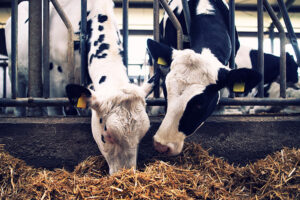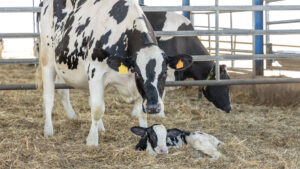The transition period is one of immense physiological and dietary changes for a dairy cow. As nutrient requirements increase to support fetal development, mammogenesis, and milk production, dry matter intake (DMI) begins to fluctuate, decreasing for several days prepartum and then increasing postpartum. Despite drastic intake improvements post calving, most cows experience negative energy balance during this time. Lactation requires a great deal of energy, and when coupled with intake fluctuations, results in a cow spending more energy producing milk than she is consuming. While we think about it less, research shows the transition period is also one of negative protein balance:
- Study 1: Negative protein balance lasted 8 weeks, with total body crude protein declining until the 8th week of lactation (Gibb et al., 1992)
- Study 2: Cows stopped losing body protein at around 5 weeks postpartum, though body fat reserves continued to be mobilized through 12 weeks of lactation (Komaragiri & Erdman, 1997).
- Study 3: For a group of Holsteins, peak negative metabolizable protein (MP) balance occurred around 7 days in milk at -600 g/d (Bell et al., 2000)
So as producers and nutritionists, what can we do to help cows move through the transition period and have a successful lactation? Ensure they are consuming adequate MP and balanced amino acids.
Quality for lack of quantity
In high producing cows, fermentable carbohydrates are a significant driver of MP in the form of microbial protein. Close-up dry cows are at a disadvantage not only because their diets are much lower in fermentable carbohydrates, but also because they consume significantly less feed compared to lactating cows. Current recommendations are to supply cows with a close-up (pre-fresh) diet that delivers around 1,300 g of MP per day (Van Saun & Sniffen, 2014). To compensate for low DMI, we must focus on the quality of the proteins fed to pre-fresh cows.
Various sources of protein and amino acids can contribute to the pre-fresh diet, as long as they are of consistent quality. In low intake situations, animal-based protein blends have an advantage over plant-based proteins because they provide highly concentrated forms of MP, with some high bypass blends providing over 350 g of MP per pound. These products can also provide a balanced amino acid profile.
Provide balanced amino acids
Delivering a balanced amino acid supply to pre-fresh cows is just as important, if not more so, than providing adequate MP. Unfortunately, there is very little work on amino acids beyond lysine and methionine in pre-fresh cows, thus recommendations for essential amino acids such as isoleucine, histidine, and arginine mimic the requirements for lactating cows. For lysine and methionine, current targets of 30-35 g metabolizable methionine and 85-95 g metabolizable lysine are appropriate.
Recent work supports the idea of feeding balanced amino acids through the transition period. At the University of Illinois, researchers found a significant response to supplementing rumen protected (RP) lysine for four weeks prepartum, with or without continuing feeding postpartum (4.1 lb DMI and 16 lb of energy corrected milk over the first four weeks postpartum). They hypothesized that the additional lysine prepartum allowed for improved mammary regeneration and thus greater productive capacity (Fehlberg, 2020). Work on RP methionine supplemented either prepartum or postpartum resulted in similar increases in components corrected milk, 5.1% and 5.0% respectively (Kudrna et al., 2009). In addition to these studies, many have supplemented RP lysine or methionine both prepartum and postpartum with positive responses in milk yield, component yield, and DMI (Zhou et al., 2016; Osorio et al., 2013; Xu et al., 1998). With fresh cows responding positively to RP amino acid supplementation in the first several weeks postpartum, there is a prime opportunity to target the utilization of RP amino acids in order to set them up for the rest of their lactation.
During the postpartum period, one significant challenge to supplying adequate MP is inconsistent intake across the pen. Cows ranging from 0 to 21+ days in milk can have drastically different appetites and production levels. When these cows are grouped in one pen, providing a one-size-fits-all diet can be challenging. To account for this when formulating, focus on feeding for a concentration of MP in the ration, rather than target total MP intake. One suggestion is to target MP at 12-14% of dry matter (French, 2016)
Fine tune management
Management through the transition period pays huge dividends in ensuring cows have adequate MP for their post-fresh needs. Reducing TMR sorting and driving intake should help feed rumen microbes and maximize their contribution to MP. Work in which casein was abomasally infused into fresh cows to meet MP requirements over and above DMI resulted in 16 lbs more milk than control cows, demonstrating that fresh cows possess the physiology to produce, we just need to get them the nutrients (Larsen et al., 2014).
In addition to a cow’s functional requirements for protein, specific amino acids can have impacts on immune health. In particular, Methionine supplementation supports and improves liver function, inflammatory responses, and gene regulation in lactating dairy cows (Vailati-Riboni, 2017). Seeing how the transition period is often fraught with liver challenges and inflammation, supplementing methionine during this time can offer the same immune response benefits. The more we can do to bolster the nutritional and immune status of a cow, the more successful she will be on entering lactation.
As we have discussed, while much consideration has been given to providing adequate energy through the transition, far less work has been done on protein and amino acid balance during this time. We must make the best use of available information to make educated decisions regarding protein supplementation in both pre-and postpartum. Using a variety of protein ingredients, including animal rendered by-products, will help to provide a balanced blend of amino acids to the cow and aid in improving health, production, performance and reproduction.
Learn how to support your cow’s protein and amino acid needs with Gemini Proteins.





